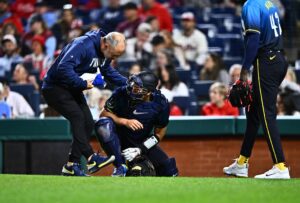1954 Cleveland Indians Overview
The 1954 Cleveland Indians team might be one of the greatest teams in MLB history. However, the team might also be one of the greatest teams to not win a World Series Championship. That season, Cleveland compiled together a 111-43 record to win the American League pennant by eight games.
Under the guidance of future Hall of Fame manager Al Lopez, the biggest shining point of the Indians was their pitching staff. As a team, the Indians allowed 504 runs while scoring 746 runs against opposing teams. In addition, there were three starting pitchers in their rotation who later became future Hall of Famers.
From an offensive perspective, the Indians finished the regular season with the second-best offense in the American League that season. As a unit, Cleveland’s lineup put up a slash line of .262/.341/.403 with 156 home runs and 714 RBI. The Brooklyn Dodgers led all of baseball in home runs in 1954 with 186, putting Cleveland fourth overall compared to the rest of baseball.
While it’s important to understand these surface-level stats, it’s also important to identify the key contributors to the Indians success that year. Below are some of the biggest contributors.
Read More: Cleveland Indians Changing Their Nickname
Starting Rotation Loaded with Future Hall of Famers
Anchoring down the starting rotation at the top was future Hall of Fame right-handed pitcher Early Wynn. Wynn concluded the regular season with a 2.73 ERA over 270 and 2/3 innings of work with a 1.138 WHIP and 155 strikeouts. Based on those stats alone, it helped the righty to finish sixth in American League Most Valuable Player Award voting. That season Wynn was dominant at home in Cleveland Municipal Stadium. Over 18 games at home, Wynn threw 11 complete games and posted a 12-4 record with a 2.54 ERA.
Another future Hall of Fame piece of the Indians starting rotation in 1954 was right-hander Bob Lemon. The right-hander earned his seventh consecutive All-Star nod that season and would go onto finish fifth in American League Most Valuable Player Award voting. Overall, Lemon concluded the regular season with a 2.72 ERA over 258 1/3 innings of work. In that span, the righty held opposing hitters to a .238 batting average against and had a 3.27 Fielding Independent Percentage (FIP).
Cleveland’s future Hall of Fame loaded starting rotation didn’t stop there, as they also had right-hander Bob Feller. Feller, 35, finished the regular season with a 3.09 ERA over 19 starts. Furthermore, Feller threw nine complete games that season.
Other Key Contributors on the Pitching Staff
If the trio of Early Wynn, Bob Lemon, and Bob Feller wasn’t enough talent for the Cleveland Indians, they had a few other key contributors on their pitching staff that season as well. For starters, Cleveland got a big season out of right-handers Mike Garcia and Art Houtteman in 1954. Garcia concluded the regular season with a career best 2.64 ERA over 258 2/3 innings of work. In that span, the righty finished with the lowest home runs-per-nine rate of his career — 0.2.
In addition, Art Houtteman made his presence felt in the starting rotation. Houtteman tossed 11 complete games during the regular season with a 15-7 record and 3.35 ERA. Throughout his career, Houtteman developed the nickname “Hard Luck Houtteman,” but that wasn’t the case for the right-hander in 1954. That was especially true in situations with runners in scoring position (RISP). In those situations, Houtteman held opposing hitters to a .209/.291/.282 slash line.
The other key contributor on Cleveland’s pitching staff was reliever Hal Newhouser. Yet another future Hall of Famer, the left-hander concluded the regular season with a 2.51 ERA over 46 2/3 innings of work. “Prince Hal,” as Newhouser was known, pitched in a total of 26 games that season making 1 start and finishing 15 games. It wound up being Newhouser’s final complete season at the big league level. Newhouser only pitched 2 1/3 innings the following year before being released by Cleveland.
Larry Doby and Al Rosen – The Lineup Table Setters
Easily the two biggest offensive contributors for the Cleveland Indians that season were center fielder Larry Doby and third baseman Al Rosen. Larry Doby, another future Hall of Famer, finished the regular season with a .274/.364/.484 slash line over 673 plate appearances. In that span, Doby hit an American League-leading 32 home runs and 126 RBI. Doby contributed enough for a 5.7 Wins Above Replacement (WAR) value.
In addition, Doby earned his sixth consecutive All-Star nod and finished second in American League Most Valuable Player Award voting that year. One fascinating oddity for Doby that season was his home/road splits. Doby hit the same amount of home runs at Cleveland Stadium (16) as he did on the road (16). Furthermore, the center fielder recorded 66 RBI at home while recording 60 on the road!
In addition, third baseman Al Rosen had a nice year for the Indians as well. The 30-year-old completed the regular season with a .300/.404/.506 slash line over 566 plate appearances. In that span, Rosen recorded 140 hits, 20 doubles, two triples, 24 home runs, 102 RBI, 85 walks, and 43 strikeouts. All together, that equaled a WAR of 4.4.
After winning the American League Most Valuable Player Award the year before, Rosen finished 15th in the voting process in 1954. In addition, Rosen earned his third consecutive All-Star nod. “Flip,” as Rosen was called by fans and teammates, had a really big first half of the season that year. Over 71 games, Rosen had a first-half slash line of .313/.401/.512. In that span, Rosen recorded 77 hits, seven doubles, 14 home runs, 59 RBI, 40 walks, and 25 strikeouts.
Other Lineup Qualities
One of the most interesting things about the Cleveland Indians lineup that year is that there wasn’t really a speedster anywhere from top to bottom. In fact, as a team the Indians finished the regular season with only 30 stolen bases — tied for last in the American League. At the same time, the team was caught stealing on 33 different occasions.
What helped the Indians lineup that season was the idea of distribution. Yes, both Larry Doby and Al Rosen were the main table setters, but there were some other key contributors as well. For instance, left fielder Al Smith set the table in the leadoff spot. Smith hit .281/.398/.435 with 135 hits, 29 doubles, six triples, 11 home runs, 50 RBI, 88 walks, and 65 strikeouts.
Another example of distribution is the idea that every hitter in the Indians lineup had at least 10 home runs outside of shortstop George Strickland. Still, Strickland had a .314 on-base percentage along with 55 walks over 433 plate appearances. In addition, Dave Philley is another Indians hitter that deserves mention. The switch-hitter recorded 12 home runs, 60 RBI, 57 walks, and a .655 OPS that season.
The Indians displayed a significant amount of plate discipline, and that also contributed to their regular-season success. As a team, the Indians recorded 637 walks during the regular season. That put them third in the American League behind the Boston Red Sox and New York Yankees.
Finally, while there was certainly distribution throughout the Indians lineup, the power wasn’t necessarily that great. As a team, the Indians finished the regular season with a .271 Batting Average on Balls In Play (BABIP). That tied them with the Cincinnati Redlegs for the fourth-lowest BABIP in all of baseball.
The Luck of the 1954 Cleveland Indians
Cleveland, otherwise known as The Tribe, had a tremendous regular season in 1954. However, once the World Series rolled around luck was definitely not in their favor especially during Game One. Everything was in the Indians favor with the score tied in the top of the eighth. That was when Vic Wertz hit a deep drive to center with runners on first and second and nobody out. It looked like it would be a base-clearing extra-base hit, but Willie Mays ran it down in “The Catch.” He then turned around and made a tremendous throw back to the infield. That throw made the runner on second stop at third on his tag-up instead of scoring. A walk, strikeout, and fly to left were all that the Indians could manage after that, wasting a golden opportunity.
The Indians’ failure to score in the eighth sent the game to the bottom of the 10th. At that point, Dusty Rhodes of the New York Giants really gave the Indians a dose of bad luck. Rhodes hit a home run that took a sharp angle to the right off of his bat only to end up barely clearing the wall. The ball bounced off the front row and back onto the field. Unfortunately for the Indians, it was a walk off home run for the Giants.
A Sweep
Game One pretty much set the stage for the rest of the World Series. New York went on to sweep Cleveland and the Cleveland Indians did not make another World Series appearance until 1995. Once again, luck was not in their favor as a strong Atlanta Braves team would go onto win the Championship in six games. It’s one of the reasons why the 2016 World Series was so special.
Regardless, the 1954 Cleveland Indians were a dominant team during the regular season with a pitching staff loaded with future Hall of Famers and an offense anchored by Larry Doby and Al Rosen. As that year’s Indians team demonstrated, you can have all the success you want during the regular season, but once the postseason rolls around, the game is an entirely different animal.
Main Photo
Embed from Getty Images






